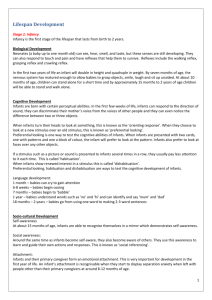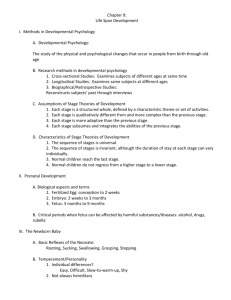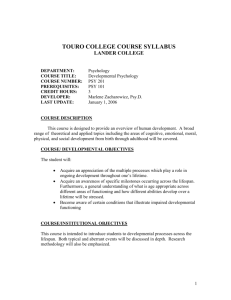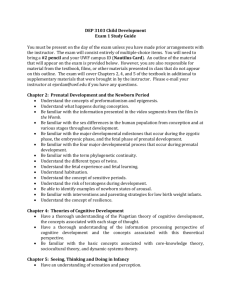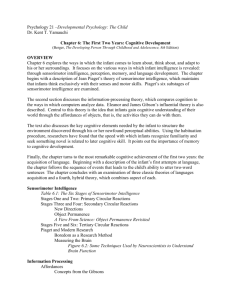Lifespan Development Stages & Theories
advertisement
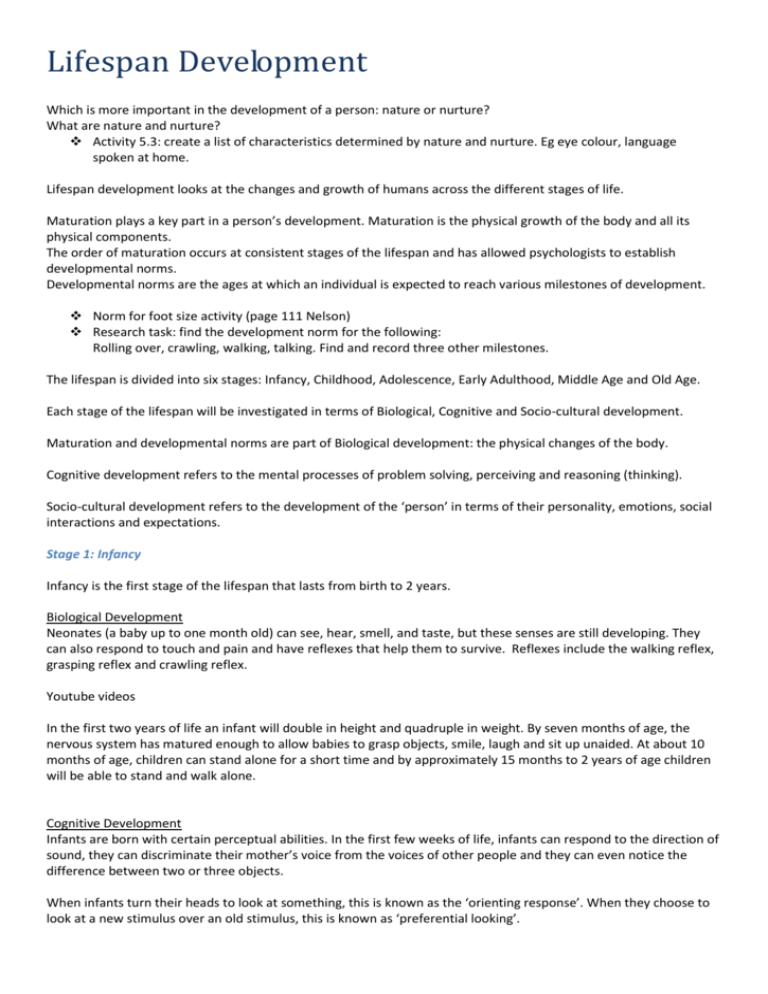
Lifespan Development Which is more important in the development of a person: nature or nurture? What are nature and nurture? Activity 5.3: create a list of characteristics determined by nature and nurture. Eg eye colour, language spoken at home. Lifespan development looks at the changes and growth of humans across the different stages of life. Maturation plays a key part in a person’s development. Maturation is the physical growth of the body and all its physical components. The order of maturation occurs at consistent stages of the lifespan and has allowed psychologists to establish developmental norms. Developmental norms are the ages at which an individual is expected to reach various milestones of development. Norm for foot size activity (page 111 Nelson) Research task: find the development norm for the following: Rolling over, crawling, walking, talking. Find and record three other milestones. The lifespan is divided into six stages: Infancy, Childhood, Adolescence, Early Adulthood, Middle Age and Old Age. Each stage of the lifespan will be investigated in terms of Biological, Cognitive and Socio-cultural development. Maturation and developmental norms are part of Biological development: the physical changes of the body. Cognitive development refers to the mental processes of problem solving, perceiving and reasoning (thinking). Socio-cultural development refers to the development of the ‘person’ in terms of their personality, emotions, social interactions and expectations. Stage 1: Infancy Infancy is the first stage of the lifespan that lasts from birth to 2 years. Biological Development Neonates (a baby up to one month old) can see, hear, smell, and taste, but these senses are still developing. They can also respond to touch and pain and have reflexes that help them to survive. Reflexes include the walking reflex, grasping reflex and crawling reflex. Youtube videos In the first two years of life an infant will double in height and quadruple in weight. By seven months of age, the nervous system has matured enough to allow babies to grasp objects, smile, laugh and sit up unaided. At about 10 months of age, children can stand alone for a short time and by approximately 15 months to 2 years of age children will be able to stand and walk alone. Cognitive Development Infants are born with certain perceptual abilities. In the first few weeks of life, infants can respond to the direction of sound, they can discriminate their mother’s voice from the voices of other people and they can even notice the difference between two or three objects. When infants turn their heads to look at something, this is known as the ‘orienting response’. When they choose to look at a new stimulus over an old stimulus, this is known as ‘preferential looking’. Preferential looking is one way to test the cognitive abilities of infants. When infants are presented with two cards, one with patterns and one a block of colour, the infant will prefer to look at the pattern. Infants also prefer to look at faces over any other objects. If a stimulus such as a picture or sound is presented to infants several times in a row, they usually pay less attention to it each time. This is called ‘habituation’. When infants show renewed interest in a stimulus this is called ‘dishabituation’. Preferential looking, habituation and dishabituation are ways to test the cognitive development of infants. Depth Perception – Gibson and Walk’s Visual Cliff Gibson and Walk wanted to find out how early infants can perceive depth. They created the Visual Cliff to test depth perception. Youtube clip Evaluation of research – visual cliff Stage 1: Infancy Cognitive Development Language development. 1 month – babies can cry to gain attention 6-8 weeks – babies begin cooing 7 months – babies begin to ‘babble’ 1 year – babies understand words such as ‘no’ and ‘hi’ and can identify and say ‘mum’ and ‘dad’ 18 months – 2 years – babies go from using one word to making 2-3 word sentences Socio-cultural Development Self-awareness At about 15 months of age, infants are able to recognise themselves in a mirror which demonstrates self-awareness. Social awareness: Around the same time as infants become self-aware, they also become aware of others. They use this awareness to learn and guide their own actions and responses. This is known as ‘social referencing’. Attachment: Infants and their primary caregiver form an emotional attachment. This is very important for development in the first year of life. An infant’s attachment is recognisable when they start to display separation anxiety when left with people other than their primary caregivers at around 8-12 months of age. Stage 2: Childhood Approximately 2-12 years of age. Childhood is divided into two sub-stages: Early childhood (2-6 years) and Late childhood (6-12 years). Biological Development Growth begins to slow after age 2. Children develop the strength to walk, run and skip as well as the coordination needed for fine motor skills such as writing and drawing. Cognitive Development The brain reaches 90% of its adult weight by about the age of 5 years. Children progress through two stages according to Piaget’s cognitive development theory: the preoperational and the concrete operational stages. The first 7 years have been found to be critical for language learning. Socio-cultural Development Children learn to play and through this activity they learn socially appropriate behaviour. The peer group takes on a bigger role in a child’s life as they reach later childhood. Stage 3: Adolescence Approximately 12-18 years of age Biological Development This is the period when humans reach reproductive maturity after progressing through puberty. Both males and females have a growth spurt (which occurs earlier in females than in males) and their bodies change due to the effects of hormones testosterone and oestrogen. Cognitive Development According to Piaget, this is when individuals reach the formal operations stage of cognitive development, which they follow into adulthood. Socio-cultural Development The peer group has an important role, with many adolescents conforming to their group norms. Depending on when puberty begins, this can have an effect on the self-esteem of young people. Stage 4: Early Adulthood Approximately 18-40 years of age. Biological Development Individuals reach their physical peak in early adulthood and then, towards the end of this period, begin to decline. Cognitive Development The final stage of Piaget’s theory, the formal operations stage, is continued from adolescence through the remaining years of life. Socio-cultural Development Many individuals become independent, supporting themselves financially and developing social relationships. Stage 5: Middle Age Approximately 40-60 years of age. Biological Development Individuals have a sensory function decline, mostly in the eyes and ears. Physically, middle age people have a decline in muscle mass and therefore strength. This decline can be slowed somewhat by careful exercise and diet control. Menopause occurs on average at 51 years of age, when women stop menstruating and become unable to reproduce. Men do not undergo any physical change that is comparable to menopause, although there is a reduction in testosterone, men are still capable of reproducing. Cognitive Development Most cognitive skills remain stable, though there may be some changes to memory function, mostly in the ability to recall information. Other methods such as recognition appear to remain stable. Socio-cultural Development Many individuals retire from work during this period. Individuals who are active socially and mentally and have a purpose in life appear to have better wellbeing during this period life. Stage 6: Old Age Approximately 60 years of age and onwards. Biological Development Physical decline such as muscular strength, flexibility, circulatory efficiency, sensory acuity and other functions. Cognitive Development The effects of ageing depend greatly on the lifestyle an individual has led up until old age, and genetics also play a role. Contrary to popular belief, intelligence test scores show very little decline with ageing, but this may depend on the type of activity being tested. Socio-cultural Development Individuals with close social relationships report better wellbeing. TASK Use the above notes and the information in your textbook to create a poster that shows the stages of a lifespan. Consider the headings and subheadings to be used and which information is of most importance to include on the poster. Theories of Development Emotional Development – Attachment Theory Bowlby Bowlby believed that the connection between adults and infants was innate. Infants behave instinctively in ways that attract the attention of adults and that adults respond by caring for the infants, thus creating a bond or attachment. Bowlby concluded that ‘to grow up mentally healthy, the infant should experience a warm, intimate and continuous relationship with his mother.’ Phases of attachment – over the first 4 years of life, infants pass through the phases of attachment. If attachment does not occur, then the child will not thrive emotionally, as well as physically and mentally. Ainsworth Ainsworth investigated separation anxiety and developed three types of attachment. 1. Secure attachment – the most common type of attachment 2. Resistant attachment. 3. Avoidant attachment Cognitive Development – Piaget Four stages of cognitive development. Sensorimotor Stage (0-2 years) – Coordination of sensory and motor information, object permanence Pre-operational Stage (2-7 years) – Symbolic thinking (words and images), no conservation, centration, egocentrism, animism Concrete Operational Stage (7-11 years) – problem solve using real objects and events, conservation, reversibility, decentration, classification Formal Operational Stage (11 – onwards) – abstract thinking using logic and reasoning Psycho-social Development – Erikson How we deal with crises at different stages of life help to shape our personalities. Erikson proposed eight stages of development. At each stage was a crisis to be overcome. Stage 1 – trust vs mistrust (first year) Stage 2 – autonomy vs shame and doubt (2-3 years) Stage 3 – initiative vs guilt (4-6 years) Stage 4 – industry vs inferiority (6-puberty) Stage 5 – identity vs confusion (Adolescence) Stage 6 – intimacy vs isolation (Early adulthood) Stage 7 – generativity vs self-absorption (Middle adulthood) Stage 8 – integrity vs despair (late adulthood) Moral Development – Kohlberg Distinguishing right from wrong. There is three levels of moral development, with two stages in each level. The stages and levels progress as we age. Level 1 – Pre-conventional level: external authority (wrong is punished, right is rewarded) Level 2 – Conventional level: rules are necessary for social order Level 3 – Post-conventional level: abstract ethical principles are applied

